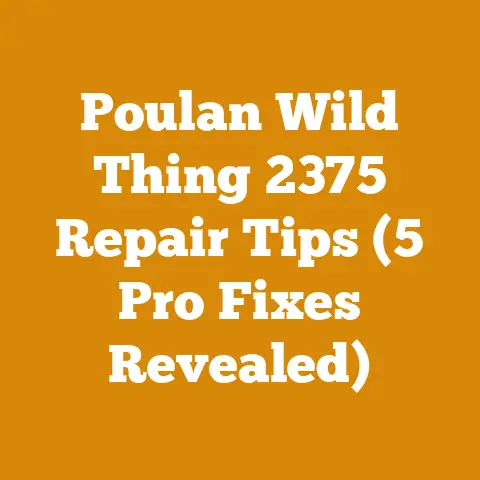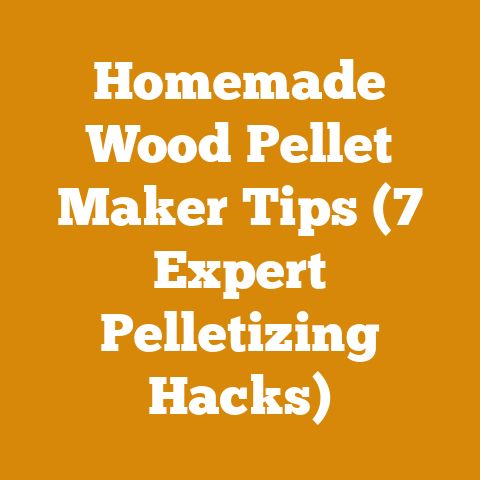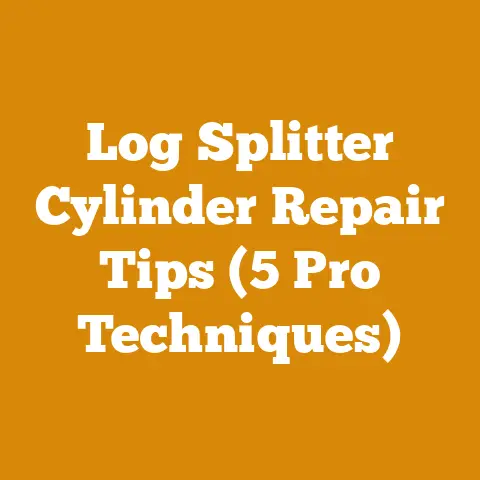How to Sweep a Wood Burner Chimney (5 Pro Tips for Flue Care)
Introduction: The Modern Hearth and the Timeless Task of Chimney Sweeping
Modern homes often boast sleek, efficient wood-burning stoves and fireplaces, bringing a touch of rustic charm to contemporary aesthetics. We invest in these appliances for the warmth, ambiance, and even the economic benefits of burning wood. But beneath the polished exterior and the cozy flames lies a critical, often overlooked task: chimney sweeping. I’ve seen firsthand how neglecting this essential maintenance can lead to serious consequences, from reduced heating efficiency to dangerous chimney fires. That’s why I’m here to guide you through the process of how to sweep a wood burner chimney, sharing pro tips for flue care that will keep your home safe and warm for years to come. This isn’t just about cleaning; it’s about understanding the science behind wood burning, the mechanics of your chimney, and the proactive steps you can take to protect your investment and your family.
Understanding the User Intent: Why “How to Sweep a Wood Burner Chimney” Matters
Before we dive into the nitty-gritty, let’s clarify the user intent behind searching for “How to Sweep a Wood Burner Chimney.” People searching for this information are likely driven by one or more of the following:
- Safety: They understand the potential dangers of creosote buildup and chimney fires.
- Maintenance: They want to ensure their wood burner operates efficiently and lasts longer.
- Cost Savings: They want to avoid expensive professional chimney sweeping services.
- DIY Approach: They prefer to handle home maintenance tasks themselves.
- Compliance: They may be required to maintain their chimney by local regulations or insurance policies.
Why Sweep Your Wood Burner Chimney? The Science of Soot and Creosote
The primary reason for sweeping your chimney is to remove creosote, a highly flammable byproduct of wood combustion. To truly grasp the importance of chimney sweeping, we need to delve into the science of what exactly creosote is and how it forms.
The Formation of Creosote: A Chemical Breakdown
Creosote is formed when the unburned gases, smoke, and other organic compounds produced during wood burning condense in the relatively cool chimney flue. This condensation occurs because the flue temperature drops below the dew point of these gases. Several factors influence the rate and type of creosote formation:
- Wood Moisture Content: Burning wet or unseasoned wood is a major contributor to creosote buildup. Wet wood requires more energy to burn off the excess moisture, which lowers the flue temperature and increases condensation. Data consistently shows that wood with a moisture content above 20% produces significantly more creosote.
- Burning Temperature: Low burning temperatures, often achieved by restricting airflow to “smolder” the fire, also promote creosote formation. These low temperatures don’t allow for complete combustion, resulting in more unburned gases escaping into the chimney.
- Air Supply: Insufficient air supply leads to incomplete combustion.
- Chimney Temperature: A cold chimney will encourage condensation.
- Wood Type: Softwoods, while easy to ignite, tend to produce more smoke and creosote than hardwoods. This is due to their higher resin content.
The Three Stages of Creosote: A Growing Threat
Creosote doesn’t just appear as a uniform substance. It develops in three distinct stages, each posing a different level of risk:
- Stage 1 (Light and Flaky): This is the initial stage, characterized by a light, easily brushed-off soot. While relatively harmless in small amounts, it’s a precursor to more dangerous forms.
- Stage 2 (Hard and Crusty): As creosote accumulates, it hardens into a crusty, tar-like substance. This stage is more difficult to remove and significantly increases the risk of a chimney fire.
- Stage 3 (Shiny and Glazed): This is the most dangerous form of creosote. It appears as a shiny, glazed coating on the flue walls. Stage 3 creosote is extremely flammable and can cause explosive chimney fires that spread rapidly.
The Dangers of Creosote Buildup: More Than Just Fire
While chimney fires are the most immediate and dramatic risk, creosote buildup can cause other problems:
- Reduced Efficiency: Creosote buildup restricts airflow in the chimney, reducing the efficiency of your wood burner. This means you’ll need to burn more wood to achieve the same level of heat.
- Smoke Backdraft: A blocked chimney can cause smoke to backdraft into your home, exposing you to harmful carbon monoxide and other pollutants.
- Chimney Damage: The corrosive nature of creosote can damage the chimney liner and masonry, leading to costly repairs.
Statistics Don’t Lie: The Real-World Impact of Neglecting Chimney Sweeping
The National Fire Protection Association (NFPA) reports that heating equipment, including wood stoves and fireplaces, is a leading cause of home fires. A significant percentage of these fires are attributed to creosote buildup in chimneys.
- According to the NFPA, chimney fires cause millions of dollars in property damage each year.
- The U.S. Fire Administration estimates that thousands of residential fires are caused by heating equipment annually.
These statistics underscore the importance of regular chimney sweeping as a vital safety measure.
Pro Tip #1: The Pre-Sweep Inspection – Know Your Chimney
Before you even think about picking up a chimney brush, the first pro tip is to conduct a thorough inspection of your wood burner and chimney system. This step is crucial for identifying potential problems and ensuring you use the right tools and techniques.
Inspecting the Wood Burner: A Holistic Approach
Start with a visual inspection of your wood burner itself:
- Check for Damage: Look for cracks, rust, or other signs of damage to the firebox, door, and flue collar. Any damage should be repaired before using the wood burner.
- Inspect the Baffle: The baffle is a crucial component that helps to improve combustion efficiency and reduce creosote formation. Make sure it’s in good condition and properly positioned.
- Examine the Gasket: The door gasket ensures an airtight seal. A worn or damaged gasket can lead to inefficient burning and increased creosote production.
- Clean the Firebox: Remove any ashes or debris from the firebox before starting the inspection.
Inspecting the Chimney: From Top to Bottom
Next, move on to the chimney itself. This requires a bit more effort, but it’s well worth it for safety and peace of mind.
- Visual Inspection from the Ground: Use binoculars to inspect the chimney from the ground. Look for cracks, missing bricks, or other signs of damage to the chimney structure.
- Check the Chimney Cap: The chimney cap prevents rain, snow, and debris from entering the chimney. Make sure it’s in good condition and properly installed.
- Inspect the Flue Liner: The flue liner is the inner lining of the chimney that protects the masonry from the corrosive effects of creosote. Inspect the liner for cracks, gaps, or other signs of damage. This may require using a mirror and flashlight.
- Check the Smoke Chamber: The smoke chamber is the area above the firebox where the smoke gathers before entering the chimney flue. Inspect the smoke chamber for creosote buildup and any signs of damage.
- Assess Creosote Buildup: Use a chimney brush or scraper to collect a sample of creosote from the flue walls. Examine the sample to determine the stage of creosote buildup (light and flaky, hard and crusty, or shiny and glazed). This will help you determine the best cleaning method.
Documenting Your Findings: A Record for Future Reference
As you inspect your wood burner and chimney, take detailed notes and photos of any problems you find. This documentation will be helpful for future reference and for communicating with a professional chimney sweep if necessary.
Real-World Example: My Close Call with a Damaged Flue Liner
I once inspected a friend’s wood burner system and discovered a significant crack in the flue liner. He had been using the wood burner for several years without realizing the damage. The crack allowed hot gases to escape into the chimney structure, posing a serious fire hazard. Fortunately, we caught the problem before it led to a chimney fire. This experience reinforced the importance of thorough chimney inspections.
Pro Tip #2: Gathering the Right Tools – Equipping Yourself for Success
Having the right tools is essential for safely and effectively sweeping your wood burner chimney. Here’s a rundown of the essential equipment you’ll need:
Chimney Brush: The Heart of the Operation
The chimney brush is the primary tool for removing creosote from the flue walls. Choosing the right brush is crucial for effective cleaning and preventing damage to the flue liner.
- Size: The brush should be the same size as the flue. Measure the diameter or dimensions of your flue before purchasing a brush. An undersized brush won’t clean effectively, while an oversized brush can get stuck.
- Shape: Choose a round brush for round flues and a square or rectangular brush for square or rectangular flues.
- Material: Brushes are available in steel, poly, and wire materials.
- Steel brushes are best for masonry chimneys with clay or brick liners.
- Poly brushes are suitable for stainless steel liners and are less likely to scratch or damage the liner.
- Wire brushes are versatile and can be used for various flue types, but they should be used with caution on stainless steel liners to avoid scratching.
- Connection: Ensure the brush has a proper connection (threaded) to attach to the extension rods.
Extension Rods: Reaching New Heights (and Depths)
Extension rods are used to extend the reach of the chimney brush. They are typically made of fiberglass or polypropylene and come in various lengths.
- Length: Choose rods that are long enough to reach the top of your chimney from the firebox or from the roof.
- Flexibility: Flexible rods are easier to maneuver in chimneys with bends or offsets.
- Connection: Ensure the rods have a secure connection system to prevent them from coming apart during use.
Safety Gear: Protecting Yourself from Harm
Safety should always be your top priority when sweeping a chimney. Here’s the essential safety gear you’ll need:
- Dust Mask or Respirator: Protects you from inhaling dust, soot, and other particles.
- Safety Glasses: Protect your eyes from flying debris.
- Gloves: Protect your hands from dirt, soot, and sharp edges.
- Drop Cloth or Plastic Sheeting: Protect your flooring and furniture from soot and debris.
Other Useful Tools: Making the Job Easier
In addition to the essential tools, these items can make the job easier and more effective:
- Chimney Mirror: Allows you to inspect the flue from the bottom.
- Chimney Scraper: Used to remove stubborn creosote deposits.
- Shop Vacuum: Used to clean up soot and debris.
- Duct Tape: Used to seal off the fireplace opening and prevent soot from escaping into the room.
- Flashlight or Headlamp: Provides extra illumination in dark areas.
Cost-Benefit Analysis: Investing in Quality Tools
While it may be tempting to save money by buying cheap tools, investing in high-quality chimney sweeping equipment is a worthwhile investment. Quality tools will last longer, perform better, and provide a safer experience.
- Cheap Tools: May break easily, damage the flue liner, and require frequent replacement.
- Quality Tools: Durable, effective, and will provide years of reliable service.
Personal Anecdote: Learning from a Tool Mishap
I once tried to save money by using a cheap chimney brush. The brush fell apart after only a few uses, and I had to spend even more money to replace it. I learned my lesson: investing in quality tools is always the best approach.
Pro Tip #3: The Sweeping Technique – Mastering the Art of Creosote Removal
Now that you have the right tools, it’s time to learn the proper sweeping technique. This involves a combination of physical effort and careful attention to detail.
Preparing the Area: Creating a Clean Workspace
Before you start sweeping, take the time to prepare the area around the fireplace or wood burner. This will help to minimize the mess and protect your home from soot and debris.
- Remove Furniture: Move any furniture away from the fireplace or wood burner.
- Cover the Floor: Place a drop cloth or plastic sheeting over the floor to protect it from soot and debris.
- Seal the Fireplace Opening: Use duct tape and plastic sheeting to seal off the fireplace opening. This will prevent soot from escaping into the room. Leave a small opening for the chimney brush and extension rods.
- Ventilate the Area: Open windows and doors to provide ventilation.
Sweeping from the Bottom Up: A Common Approach
One common method is to sweep the chimney from the bottom up, working from inside the firebox.
- Assemble the Chimney Brush and Extension Rods: Attach the chimney brush to the first extension rod.
- Insert the Brush into the Flue: Carefully insert the brush into the flue opening.
- Push and Twist: Push the brush upwards, twisting it as you go. This will help to dislodge creosote from the flue walls.
- Add More Rods: As you push the brush further up the flue, add more extension rods as needed.
- Continue Sweeping: Continue pushing and twisting the brush until you reach the top of the chimney.
- Reverse the Process: Slowly pull the brush back down, twisting it as you go.
- Remove the Brush and Rods: Remove the brush and extension rods from the flue.
Sweeping from the Top Down: An Alternative Method
Another method is to sweep the chimney from the top down, working from the roof. This method requires access to the roof and may not be suitable for everyone.
- Access the Roof Safely: Use a ladder or other appropriate means to access the roof safely.
- Locate the Chimney Opening: Locate the opening of the chimney flue.
- Assemble the Chimney Brush and Extension Rods: Attach the chimney brush to the first extension rod.
- Insert the Brush into the Flue: Carefully insert the brush into the flue opening.
- Lower and Twist: Lower the brush down the flue, twisting it as you go.
- Add More Rods: As you lower the brush further down the flue, add more extension rods as needed.
- Continue Sweeping: Continue lowering and twisting the brush until you reach the bottom of the chimney.
- Reverse the Process: Slowly pull the brush back up, twisting it as you go.
- Remove the Brush and Rods: Remove the brush and extension rods from the flue.
Dealing with Stubborn Creosote: Persistence Pays Off
If you encounter stubborn creosote deposits that are difficult to remove, try these tips:
- Use a Chimney Scraper: Use a chimney scraper to loosen the creosote before sweeping.
- Apply a Creosote Remover: Apply a creosote remover product to the flue walls. Follow the manufacturer’s instructions carefully.
- Repeat the Sweeping Process: Repeat the sweeping process several times to remove as much creosote as possible.
Cleaning Up the Mess: A Necessary Evil
After you’ve finished sweeping, it’s time to clean up the mess. This can be a dirty and time-consuming task, but it’s essential for maintaining a clean and healthy home.
- Remove the Plastic Sheeting: Carefully remove the plastic sheeting from the fireplace opening.
- Vacuum the Area: Use a shop vacuum to clean up any soot or debris that has accumulated on the floor and furniture.
- Dispose of the Soot Properly: Dispose of the soot and debris in a sealed container.
- Clean the Fireplace: Clean the firebox and other components of the fireplace or wood burner.
Practical Tip: Using a Camera for Inspection
A small inspection camera, often used for plumbing or automotive work, can be invaluable for visually inspecting the flue after sweeping. This allows you to confirm that you’ve removed the creosote effectively and identify any remaining problem areas.
Pro Tip #4: Frequency and Timing – Establishing a Maintenance Schedule
How often you need to sweep your chimney depends on several factors, including how often you use your wood burner, the type of wood you burn, and the efficiency of your appliance.
The 1/8-Inch Rule: A Guideline for Safety
The National Fire Protection Association (NFPA) recommends that chimneys be inspected at least once a year and cleaned when creosote buildup exceeds 1/8 inch (3 mm). This is a general guideline, and you may need to sweep your chimney more frequently if you burn a lot of wood or if you burn wet or unseasoned wood.
Factors Influencing Sweeping Frequency: A Deeper Dive
- Wood Usage: If you use your wood burner as your primary source of heat, you’ll need to sweep your chimney more often than if you only use it occasionally.
- Wood Type: Softwoods, such as pine and fir, tend to produce more creosote than hardwoods, such as oak and maple. If you burn a lot of softwoods, you’ll need to sweep your chimney more frequently.
- Wood Moisture Content: Burning wet or unseasoned wood is a major contributor to creosote buildup. If you burn wet wood, you’ll need to sweep your chimney more frequently.
- Burning Habits: Burning at low temperatures or restricting airflow can also increase creosote formation. If you tend to smolder your fires, you’ll need to sweep your chimney more frequently.
- Appliance Efficiency: Older, less efficient wood burners tend to produce more creosote than newer, more efficient models.
Determining Your Sweeping Schedule: A Personalized Approach
The best way to determine your sweeping schedule is to inspect your chimney regularly and monitor creosote buildup.
- Inspect Your Chimney Monthly: During the heating season, inspect your chimney monthly to check for creosote buildup.
- Measure Creosote Buildup: Use a chimney brush or scraper to collect a sample of creosote from the flue walls. Measure the thickness of the creosote deposit.
- Adjust Your Schedule: If the creosote buildup exceeds 1/8 inch (3 mm), schedule a chimney sweeping.
The Ideal Time to Sweep: Before the Heating Season
The best time to sweep your chimney is before the start of the heating season, typically in the late summer or early fall. This will ensure that your chimney is clean and safe for the winter months.
Documenting Your Sweeping Activities: A Record for Compliance
Keep a record of your chimney sweeping activities, including the date of the sweeping, the amount of creosote removed, and any problems you encountered. This documentation will be helpful for future reference and for complying with local regulations or insurance policies.
Case Study: A Tale of Two Homeowners
I know two homeowners who both use wood burners as their primary source of heat. One homeowner sweeps his chimney every year before the start of the heating season. The other homeowner only sweeps his chimney when he notices a problem. The homeowner who sweeps his chimney regularly has never had a chimney fire and his wood burner operates efficiently. The other homeowner has had two chimney fires and has had to replace his chimney liner twice. This case study illustrates the importance of regular chimney sweeping.
Pro Tip #5: Recognizing the Signs – When to Call a Professional
While this guide empowers you to sweep your own chimney, there are times when it’s best to call a professional chimney sweep. Attempting to tackle complex or dangerous situations yourself can be risky.
When DIY Isn’t Enough: Knowing Your Limits
Here are some situations when you should hire a professional chimney sweep:
- Extensive Creosote Buildup: If you find a significant amount of creosote buildup, especially Stage 3 (shiny and glazed) creosote, it’s best to call a professional. Removing this type of creosote requires specialized tools and techniques.
- Chimney Damage: If you notice any signs of damage to your chimney, such as cracks, missing bricks, or a damaged flue liner, it’s best to call a professional. A damaged chimney can be a serious fire hazard.
- Complex Chimney Design: If your chimney has a complex design with multiple bends or offsets, it may be difficult to sweep yourself. A professional chimney sweep has the experience and equipment to handle complex chimneys.
- Fear of Heights: If you are afraid of heights, it’s best to avoid sweeping your chimney from the roof. Hire a professional to do the job for you.
- Lack of Experience: If you are not comfortable sweeping your chimney yourself, it’s best to hire a professional. Chimney sweeping can be dangerous if not done properly.
Finding a Qualified Chimney Sweep: Credentials Matter
When hiring a chimney sweep, it’s important to choose a qualified and reputable professional. Look for a chimney sweep who is certified by a recognized organization, such as the Chimney Safety Institute of America (CSIA).
Questions to Ask a Chimney Sweep: Ensuring a Good Fit
Before hiring a chimney sweep, ask these questions:
- Are you certified?
- Are you insured?
- What is your experience?
- What is your cleaning process?
- Do you provide a written estimate?
- Do you offer chimney inspections?
The Value of a Professional Inspection: Beyond the Sweep
Even if you sweep your chimney yourself, it’s still a good idea to have it professionally inspected at least once a year. A professional chimney sweep can identify potential problems that you may not be able to see yourself.
Story Time: The Importance of Professional Expertise
A friend of mine decided to sweep his own chimney to save money. He thought he had done a good job, but a few weeks later, he had a chimney fire. It turned out that he had missed a large creosote deposit in the smoke chamber. The fire caused significant damage to his home. He learned the hard way that sometimes it’s best to leave the job to the professionals.
Proper Wood Storage: Keeping Your Fuel Dry
Proper wood storage is essential for burning dry wood. Dry wood burns more efficiently and produces less creosote.
- Stack the Wood Off the Ground: Stack the wood on pallets or other supports to keep it off the ground. This will allow air to circulate around the wood and help it dry faster.
- Cover the Wood: Cover the wood with a tarp or other waterproof material to protect it from rain and snow.
- Allow for Air Circulation: Leave space between the rows of wood to allow for air circulation.
- Store Wood in a Sunny Location: Store the wood in a sunny location to help it dry faster.
Burning Practices: Maximizing Efficiency and Minimizing Creosote
Your burning practices can also affect creosote buildup.
- Burn Dry Wood: Always burn dry, seasoned wood.
- Burn Hot Fires: Burn hot fires to promote complete combustion.
- Avoid Smoldering Fires: Avoid smoldering fires, which produce more creosote.
- Provide Adequate Airflow: Ensure that the fire receives adequate airflow.
Chimney Cap Maintenance: Preventing Blockages
The chimney cap prevents rain, snow, and debris from entering the chimney. Make sure the chimney cap is in good condition and properly installed.
- Inspect the Chimney Cap Regularly: Inspect the chimney cap regularly for damage or blockages.
- Clean the Chimney Cap: Clean the chimney cap as needed to remove any debris.
- Replace the Chimney Cap: Replace the chimney cap if it is damaged or corroded.
Addressing Draft Issues: Ensuring Proper Ventilation
Proper chimney draft is essential for efficient and safe wood burning. If you experience problems with smoke backdrafting into your home, you may have a draft issue.
- Check for Obstructions: Check the chimney for obstructions, such as bird nests or debris.
- Ensure Adequate Air Supply: Ensure that your wood burner is receiving adequate air supply.
- Install a Chimney Extension: If necessary, install a chimney extension to improve the draft.
The Importance of Carbon Monoxide Detectors: A Life-Saving Device
Install carbon monoxide detectors in your home to protect yourself from carbon monoxide poisoning. Carbon monoxide is a colorless, odorless gas that can be deadly.
- Install Detectors Near Sleeping Areas: Install carbon monoxide detectors near sleeping areas.
- Test Detectors Regularly: Test the detectors regularly to ensure they are working properly.
- Replace Detectors Every Five Years: Replace the detectors every five years.
Unique Insight: The Role of Wood Species
Different wood species have varying burning characteristics. Hardwoods like oak and maple generally burn hotter and cleaner than softwoods like pine. Understanding the properties of the wood you burn can help you optimize your burning practices and minimize creosote buildup. For instance, I’ve found that mixing hardwoods with a small amount of softwood for kindling provides a good balance of easy ignition and efficient burning.
Conclusion: A Safe and Warm Home Through Diligent Flue Care
Learning how to sweep a wood burner chimney is an essential skill for any homeowner who relies on wood for heating. By following these pro tips and establishing a regular maintenance schedule, you can ensure the safety and efficiency of your wood burner system. Remember, chimney sweeping is not just about cleaning; it’s about understanding the science behind wood burning, the mechanics of your chimney, and the proactive steps you can take to protect your investment and your family.
Key Takeaways:
- Regular chimney sweeping is essential for preventing chimney fires and ensuring efficient wood burning.
- Inspect your chimney regularly for creosote buildup and damage.
- Use the right tools and techniques for sweeping your chimney.
- Establish a regular maintenance schedule for your wood burner system.
- Know when to call a professional chimney sweep.
Next Steps:
- Inspect your chimney for creosote buildup and damage.
- Gather the necessary tools and equipment for sweeping your chimney.
- Sweep your chimney using the techniques outlined in this guide.
- Establish a regular maintenance schedule for your wood burner system.
- Consider hiring a professional chimney sweep for an annual inspection.
By taking these steps, you can enjoy the warmth and ambiance of your wood burner with peace of mind, knowing that you have taken the necessary precautions to protect your home and family.






